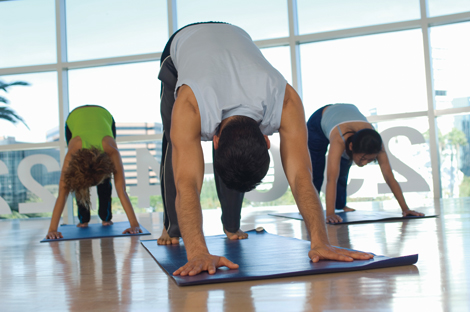
To begin, always stretch your muscles before and after your workout, focusing on the areas you are training. Core muscles, in the stomach area and mid- to lower-back, are often neglected. But these muscles are the foundation of the body, and if they are weak, everything you do will be compromised and you’ll be prone to injuries.
• Bird dog plank is an excellent exercise for the core that you can do anywhere, barefoot. Get into the push-up position; extend one of your arms and the opposite leg until they are parallel to the floor, with the palm facing inwards; hold for 30 to 60 seconds. Return to your starting position and rest with your knees down. Repeat with the other arm and leg. Ensure your back is flat and your tummy tucked in.
• A strong core will also help you do sit-ups correctly, otherwise, you could end up straining your lower back and neck as your instincts prompt you to use other muscles to compensate for the lack of strength.
• Many people don’t realise they do push-ups incorrectly. Your hands should be slightly more than shoulder-width apart, your butt should be clenched and abs braced so that your body is in a straight line. It’s important to make sure that you do not shrug – meaning your shoulders should be kept away from your ears. In the lowered position, your shoulder blades should be squeezed, and your arms should be bent 90-degrees.
• Push-ups can also be used to train your triceps, but in this case, you need to keep your arms and elbows close to your torso. Feel it work the back of your upper arms.

• Alternatively, you can use the bed bench to work the triceps. With your back facing the bed, press both of your hands onto it with fingers facing forward; bend your legs so that your body weight is supported by your arms; then bend both of your arms at the same time and lower your body weight towards the ground, stopping when your upper arms are parallel to the floor. Hold this position for a second, then straighten your arms to return to the starting position; repeat until you are exhausted. Arms should be close to your torso when bent. Your butt should be close to the bench, and you can move the feet further out for more intensity.
• Your legs are your biggest muscle group, and exercising them regularly can help you burn calories more quickly. Strong leg muscles also reduce the strain jogging has on your knee joints.
• Squats are the ideal exercise for legs. Stand with your feet slightly wider than your hips; brace your abs, shift your weight back onto your heels and lower yourself like you are sitting in an invisible chair, until the knees are bent to 90 degrees; exhale and return to the starting position. Repeat eight to ten times as one set; try two to three sets with a one-to-two minute rest in-between. When squatting, your knees should be behind your toes pointing in the same direction.
• Lunges are good for training muscles around the buttocks, thighs and hamstrings. A long stride will put focus on the first group while a shorter stride (both knees bent at 90 degrees) will shift the intensity to the other two. They can be done using just your bodyweight alone. When lunging, the back leg should remain strong for balance, with the heel facing up. Keep your back upright and straight.
• Always incorporate some cardio. One option without shoes is the burpee. From standing, drop into a squat, put your hands on the ground and kick your feet back while keeping your arms extended. Pulse for two and jump back to the squat position. You can add a small jump at the end. Make sure your core is braced when you are planking.
Special thanks to Fiji Fitness (fijifitness.com.hk)
Sponsored by Oasia Hotel Singapore











